Location:Russia
Elevation:4 835 meters
Rising to a height of 4, 750 meters, Klyuchevskaya Volcano, or Klyuchevskaya Sopka in Russia is one of the world’s highest active volcanoes. It is located in the Kamchatka Peninsula, far eastern Russia. It has a symmetrical and steep cone that towers about 100 kilometers from the Bering Sea. The volcano has a central crater, and with several 70 lateral craters and cones on the lower slopes.
Since 1700, the volcano has already erupted 50 times. It is characterized by smoke continuously billowing its summit. At the base of the mountain is the Kamchatka Volcanological Station, established in 1935.
In 1788, the mountain was first climbed by Daniel Gauss and two other members of the Billings Expedition. After that year, no other ascents were recorded until 1931 when the flowing lava killed several climbers on their descent. Today, there are still similar dangers, but a few ascents succeed.
Some indigenous people consider Klyuchevskaya Sopka a sacred mountain where the world was created. Some other volcanoes in the region were of similar spiritual significance, but Klyuchevskaya Sopka is the most sacred of these.
How to Get There
From Petropavlovsk-Kamchatskij, you need to fly nearly 30 kilometers to Elizovo (the only one international airport at Kamchatka-peninsula). There are accommodations in Elizovo/Yelizovo, or you can transfer to Petropavlovsk-Kamchatskij or Paratunka. Besides hotels, you can stay at hostels like accommodation in Severovostok in “Lyznaja baza Lesnaja,” that’s the main center of XC skiing at Kamchatka. You can have a bus ride in any two companies that offer connecting ride between P-K and Klyuchi several times a week. It would be best if you buy tickets in advance, which cost approximately 600 RUR.
Travel can be either on water or on air. Travel can last up to 11 hours, depending on a ferry over the Kamchatka river near Kozyrevsk. Renting a van that can accommodate up to 8 persons is a good option for a small group with equipment. It is nearly 58 kilometers from Klyuchi to an almost 2000 meters altitude on the Klyuchevskaja’s conus north side. The last option is to travel via a helicopter from Kozyrevsk – mostly to the base camp on the south side of the volcano.
When is the Best Time to Climb
The mountain can be climbed at any time of the years. However, the weather is harsher from autumn to mid-spring, causing the climb to be more difficult and dangerous, but during summer, climbs are easy all over the volcano. Suppose you want to ski alongside trekking, it’s recommended going from the end of March to mid-May. The north region has better conditions, while the snow line on the south side is much thicker. The volcano’s surface is characterized by various snow, ice, glaciers, and a lot of rocks and stones. The summit has soft snow due to intense volcanic activity.
Mountain Conditions
Despite the good weather in summer, extra caution is also needed as there are some falling rocks and stones. For instance, in 2003, a Czech tourist died when hit by a stone on Klyuchevskaja’s slope, and several members of the rescue team were also injured. It will help if you wear a helmet when traversing rocky areas. However, in some regions, the ice and snow have stabilized the stones. For those who will climb the volcano in winter and spring, don’t forget to bring crampons and ice-ax, an avalanche transceiver, snow shovel, and other necessary equipment.
The summit has the most challenging part of the climb due to the intense volcanic activity, extreme temperature, gases, visibility, etc. There are also some falling stones and rocks during the ascent. The advance camp is typically set up from the north/northwest at 2700-2900 meters.
Camping
Camping can be done anywhere in the area – digging, bivouac, or snow caves. Moreover, you can use any of several volcanologist’s huts/bases. The pass between Kamen and Klyuchevskaya is the most prominent area to put a base camp from the south. From this point, the ascent to both peaks is possible. It would be a hassle to get to the pass if you either approach the northwest or the southeast.
From northwest you have to traverse an enormous cloudy glacier, and it will be a long ascend in deep snow from the southeast. Nevertheless, both approaches are beautiful hikes. When you bring a multifuel stove, be prepared to clean it a lot. The fuel obtained in Petropavlovsk is kerosene or diesel, and it is impossible to get gas canisters at Kamchatka.
Regulations
You need to secure a valid tourist Russian visa and registration at OVIR for all foreigners within three days of your fly in Kamchatka. You must also have a special permit for Klyuchi and Klyuchevskaja as it is a border and army zone. All these can be managed through several of Kamchatka’s travel agencies.

